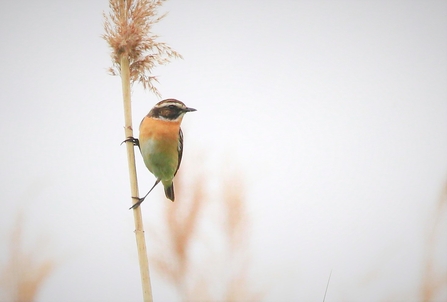
Whinchat
Photo credit: Chris Farthing
Mute swan and cygnets
Photo credit: Chris Farthing

Whinchat
Photo credit: Chris Farthing
It was the second peak in this unusual spring migration period which brought the most interesting passage migrants here. Most notable was a whinchat (above) on the 31st. This species is probably seen a bit less than once a year here, with more spring records than autumn records, unusual for a passage migrant. Two little ringed plovers were seen briefly on one of the tern rafts on the 22nd. This species is almost guaranteed to be seen on migration if the reservoir water level is low at the right time, but we have had a few years now with very few sightings. Two swallows passed over on the 31st.
Oyster catcher
Photo credit: Chris Farthing
May is usually a quiet month for ducks, and the only notable visitor was a shelduck seen on the 12th. The following day saw a flyover oystercatcher (above), this is another species which we are lucky to see once a year here.
Little egret
Photo credit: Chris Farthing
After being seen all through April, little egrets (above) continued to be a feature here for most of May, usually being seen fishing near the water inlet. Common terns (below) were seen throughout May, with one pair showing a lot of interest in one of our tern rafts.
Two common terns
Photo credit: Chris Farthing
A pair of peregrines (below) were also very frequent visitors for most of May, and could often be found on the cranes of the building site next door.

A pair of peregrines
Photo credit: Chris Farthing
Mid-May is usually hatching time for the local mute swans (below) and this year was no exception with 13 cygnets hatching between the reservoir pair and the adjacent New River pair. Things didn’t go well for the reservoir youngsters but the New River brood were still going strong at the end of the month.
Mute swan and cygnets
Photo credit: Chris Farthing
We saw some good warbler passage at the start of May with whitethroat being seen on the 1st and 4th, lesser whitethroat on the 2nd and 10th, and a willow warbler on the 5th. Two pair of sedge warblers appear to have settled here to breed, along with two pairs of reed bunting (below).
Reed bunting
Photo credit: Chris Farthing
Other notable sightings during May were a flyover jackdaw on the 7th, an unseasonal kingfisher on the 21st, and a female kestrel on the 24th.
The total number of bird species seen here in May 2023 was 64, quite a low total compared with previous Mays (average 68), high water levels probably being the most significant factor.